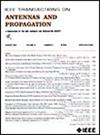Two-Dimensional Beam-Scanning Broadband Circularly Polarized Transmitarray With Low Sidelobe Level
IF 5.8
1区 计算机科学
Q1 ENGINEERING, ELECTRICAL & ELECTRONIC
引用次数: 0
Abstract
This article presents a broadband 2-D beam-scanning circularly polarized (CP) transmitarray with low sidelobe level (SLL) for millimeter-wave (mmW) applications. A polarization conversion unit cell, capable of receiving linearly polarized (LP) incidence and transmitting CP radiation, is first designed. Based on the geometric phase (GP) compensation strategy, a full 360° transmission phase with good CP radiation performance is achieved by rotating the transmitting element. Moreover, the quad-focal phase compensation scheme is implemented to construct the GP phase distribution required by 2-D beam scanning to minimize the scanning loss of the transmitarray. To lower the SLL during large-angle beam scanning, the multiobjective particle swarm optimization (MOPSO) algorithm is further employed to refine the phase distribution across the transmitting layer. For validation, a fully functional prototype of the proposed transmitarray illuminated by a movable LP horn is fabricated and measured. The measured results show a wide overlapped 3-dB gain and axial ratio (AR) bandwidth of 26% with a peak gain of 21.5 dBic. Besides, the measured SLL remains below −11.4 dB within a scan range of ±34° in two orthogonal planes. These preferred features make it a promising candidate for various mmW applications such as satellite communication systems.低旁瓣电平二维波束扫描宽带圆极化发射阵列
本文提出了一种用于毫米波应用的低旁瓣电平宽带二维波束扫描圆极化发射阵列。首先设计了一种既能接收线极化入射又能发射CP辐射的偏振转换单元电池。基于几何相位(GP)补偿策略,通过旋转发射元件获得具有良好CP辐射性能的全360°传输相位。此外,采用四焦相位补偿方案构建二维波束扫描所需的GP相位分布,以减小发射阵列的扫描损耗。为了降低大角度波束扫描时的SLL,进一步采用多目标粒子群优化(MOPSO)算法对发射层的相位分布进行细化。为了验证,制作并测量了一个由可移动LP喇叭照明的全功能发射阵列原型。测量结果表明,3db增益宽重叠,轴比(AR)带宽为26%,峰值增益为21.5 dBic。此外,在两个正交平面的±34°扫描范围内,测量到的SLL保持在−11.4 dB以下。这些首选特性使其成为各种毫米波应用(如卫星通信系统)的有希望的候选者。
本文章由计算机程序翻译,如有差异,请以英文原文为准。
求助全文
约1分钟内获得全文
求助全文
来源期刊
CiteScore
10.40
自引率
28.10%
发文量
968
审稿时长
4.7 months
期刊介绍:
IEEE Transactions on Antennas and Propagation includes theoretical and experimental advances in antennas, including design and development, and in the propagation of electromagnetic waves, including scattering, diffraction, and interaction with continuous media; and applications pertaining to antennas and propagation, such as remote sensing, applied optics, and millimeter and submillimeter wave techniques

 求助内容:
求助内容: 应助结果提醒方式:
应助结果提醒方式:


